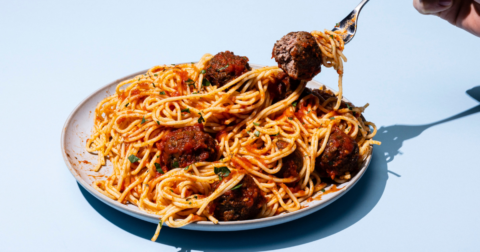Feature
How America’s Largest Meat Company Leverages Palantir’s Surveillance Tech
Food•10 min read
Reported
As cultivated meat clears U.S. approval for sales, Omeat launches with a new strategy to ditch the controversial fetal bovine serum.


Words by Björn Ólafsson
Meat made from animals, but without the slaughter — that’s the vision of the nearly 160 cultivated meat companies working to grow meat from cells rather than sourcing it from factory farms. But the nascent industry isn’t entirely slaughter-free, at least, not yet. When the handful of start-ups in the industry first began formulating lab grown meat, most used something called fetal bovine serum or FBS, the liquid part of the blood that is primarily sourced from unborn cow fetuses. It’s a powerful ingredient for growth, but it’s also expensive and controversial. Many companies in the space have been working on eliminating it from their process entirely, all with varying degrees of success. Now, one new contender – Omeat – is hoping to leave FBS behind, with a different approach to the animals bound up in its system.
“It all goes to the basic assumptions that we have about what it takes to meet this challenge.” says Ali Khademhosseini, the founder of Omeat – a cultivated meat company launching out of stealth today. “Other companies are mostly trying to fully eliminate animals,” says the biomedical researcher whose resume includes MIT, UCLA and Harvard. Omeat has a different strategy. “We try to address the challenges without having to do that,” he says.
Can animals be part of the process of creating meat without suffering harm? Omeat thinks the answer is yes. And the company’s launch coincides with some important industry news: Upside Foods and Good Meat have now both been approved to sell cultivated meat in the United States.
To grow a piece of cultivated meat, researchers usually need two forms of cells: starter cells and growth serums. Starter cells come from whatever animal you want to recreate — it could be a chicken or a cow or a pig. These cells need only be collected once, in a process that is relatively painless for the animal. One cow could theoretically feed millions, because the cells are capable of dividing indefinitely. “There’s literally billions and billions of times expansion,” explains Khademhosseini.
What happens next is the growth stage. Scientists take the initial clump of cells and grow it into a bigger blob, aiming for a burger or a nugget. In order to do that, the cells need the same boost of material that any growing body needs — a goopy sludge of salts, amino acids and serums that trigger the starter cells to begin the growth process.
Also called “basal media,” this sludge-like growth medium has been around for decades, typically used to cultivate transplant organs. Historically, the basal media was made from fetal bovine serum, often referred to as FBS in the industry.
FBS is normally collected from unborn cow fetuses when the mother is slaughtered. The way FBS is sourced poses a thorny ethical challenge — and an enormous cost — for the cultivated meat industry. Can a product truly be called “slaughter-free” when it uses something sourced from a dead cow?
According to Khademhosseini, nearly all cultivated meat companies are now trying to replace FBS in the same way — by using recombinant proteins — strings of amino acids that have been genetically tinkered with in order to stimulate growth in the same way that the FBS does.
Omeat has a different approach, one that involves keeping the cows — who are very much alive — in the picture. Says Khademhosseini, “adult organisms have a lot of regenerative capability.” Just like all other animals, cows possess “growth factors” in their blood that enable them to grow and repair damage.
Could these growth factors be the key to scaling up the industry? And, is there a way to be able to retrieve them from animals in a way that doesn’t really cause harm, wonders Khademhosseini. Even better, could it be done so that “the animal can live a full life and actually create conditions that solve all of the challenges that we’re trying to solve?”
A tall order, perhaps, but Khademhosseini sounds confident. Omeat plans to extract proteins from the blood plasma of living cows on a continual basis, using the animals as a renewable source of basal media from which the company can cultivate beef. These same proteins can theoretically be used to create cultivated chicken or pork too, though for now, Omeat is focused solely on beef.
The Southern-California-based company currently has their own farm with 75 cows — each of whom donates plasma cells on a weekly or biweekly basis. Just how much each cow donates is based on their body weight. And, at least by Khademhosseini’s estimates, Omeat’s process could reduce the number of cows needed to create meat by 95 percent or more.
While this new proposed cultivated meat model does involve animal agriculture, it doesn’t involve slaughterhouses, at least according to the company’s own descriptions. Though it wouldn’t qualify as vegan — animals are an ongoing source of plasma and cells — the final product would require far less suffering than a factory farm. These cows can theoretically live their entire lives on large farms until dying of natural causes. “The incentive for slaughtering animals goes away,” says Khademhosseini.
Omeat’s head of veterinary and farm operations, Cordell Bennigson, says the welfare of the cows is a top priority. The animals are free to roam the pasture, which the company describes as “perennial grasses and clover,” and they receive frequent wellness checks and physicals from trained animal handlers hired by the company.
The plasma extraction process, which takes about eight liters of blood in sessions that can last up to four hours, was designed to minimize stress. Led by Dr. Kristina Horback, an animal behaviorist from U.C. Davis, the system rewards the animals with treats and gives them anesthesia to keep pain to an absolute minimum.
“We wanted to ensure that our process not only provided very good living conditions,” says Khademhosseini, pointing to the ample space allotted for grazing, “but at the same time that the extraction process was not hurting them in any way.”
Still, Omeat’s model isn’t entirely free of ethical challenges. Bennigson says that cows no longer able to donate plasma are sold to cattle farmers, though he adds that Omeat is currently looking for animal sanctuaries to take them instead, a more ethical alternative. He did not comment on how the company determines when cows will no longer be able to donate plasma or how often they’d be sold to farms.
At scale, maintaining in-house farms may ultimately present a challenge for Omeat. Khademhosseini leaves open the possibility of leasing out the blood extraction process to animal farmers, who would need to meet rigorous ethical and sustainability criteria in order to sell plasma to the company.
While research shows cell-cultured meat can be created without FBS, what’s not clear is whether the industry can do it at scale. As of yesterday, two companies — Upside Foods and Good Meat — have now been approved to sell cultivated meat in the U.S.
As part of the regulatory process, the companies submitted a letter to the FDA outlining their intended production methods. Upside’s letter mentioned bovine serum and trypsin (another animal-derived ingredient) while Good Meat’s letter mentioned FBS specifically, although they intend to submit an amendment circumventing the controversial serum.
In January of this year, Good Meat became the first company approved to sell FBS-free cultivated meat in Singapore. For two years prior, the company had been using FBS in small amounts.
In a statement to Sentient Media, a representative from Eat Just (Good Meat’s parent company) said that the company is “still in the process of transitioning to a serum-free formula in Singapore.” The research into their proprietary FBS alternative suggests it will be cheaper and easier to scale.
Upside Foods did not respond to Sentient Media’s request for comment, although they demonstrated their own animal-free cultivation media in late 2021. Exactly how much FBS will be present in their future sales remains unclear, including whether any will be present at all.
The Dutch cultivated meat company Mosa Meat also announced they have moved away from FBS in their production. They published their method in Nature in 2022, although this new method has yet to pass regulatory approval.
Now, with the breaking news that the U.S. has become the second country to approve the sale of cultivated meat, a handful of elite restaurants will likely begin serving the product within a few weeks — albeit still at a steep cost.
Critics continue to say the cultivated meat industry’s long range goals are impossible — the price of recombinant proteins may never reach a low enough point to ensure a competitively priced cell-cultured steak. Despite those naysayers, Upside Foods, Good Meat and many more are racing to scale up their production — both to bring down the cost and to remove any fetal bovine serum from their factories. If Omeat’s gambit pays off, that race may just fizzle before it even has a chance to really get started. Either way, what happens over the next several years could eventually set the standard for the entire industry.